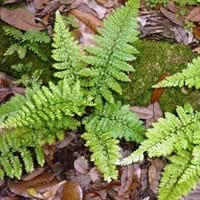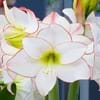Life Span
Perennial
Perennial
Type
Bulb or Corm or Tuber
Fern
Origin
Hybrid origin
North America, Africa
Types
Not Available
Asplenium platyneuron platyneuron, Asplenium platyneuron incisum, Asplenium platyneuron bacculum-rubrum
Number of Varieties
Not Available
Habitat
tropical environments
Moist Soils, Old fields, Sandy areas, Shaded sites
USDA Hardiness Zone
8-11
3-8
AHS Heat Zone
Not Available
9-1
Sunset Zone
21,22
Not Available
Habit
Clump-Forming
Rosette/Stemless
Flower Color
White, Red, Light Pink
Non Flowering Plant
Flower Color Modifier
Bicolor
Bicolor
Fruit Color
Green, Brown
Non Fruiting Plant
Leaf Color in Spring
Green, Dark Green
Green
Leaf Color in Summer
Light Green
Green
Leaf Color in Fall
Several shades of Green
Green
Leaf Color in Winter
Light Green
Not Available
Leaf Shape
Long Linear
Pinnate
Plant Season
Spring, Summer, Winter
Spring, Summer, Fall
Sunlight
Full Sun, Partial Sun
Full Shade, Partial shade
Growth Rate
Medium
Medium
Type of Soil
Loam, Sand
Loam, Sand
The pH of Soil
Acidic, Neutral
Acidic, Neutral
Soil Drainage
Well drained
Well drained
Bloom Time
Not Available
Not Available
Tolerances
Deer resistant
Drought, Variety of soil types
Where to Plant?
Container, Ground, Pot
Container, Ground, Pot
How to Plant?
Divison, From Rhizomes, Tubers
Spores
Plant Maintenance
Low
Medium
Watering Requirements
Average Water Needs
Water occasionally
In Summer
Lots of watering
Lots of watering
In Spring
Moderate
Moderate
In Winter
Average Water
Average Water
Soil pH
Acidic, Neutral
Acidic, Neutral
Soil Type
Loam, Sand
Loam, Sand
Soil Drainage Capacity
Well drained
Well drained
Sun Exposure
Full Sun, Partial Sun
Full Shade, Partial shade
Pruning
Cut or pinch the stems, Remove damaged leaves, Remove dead branches, Remove dead leaves
Remove damaged leaves, Remove dead branches, Remove dead leaves
Fertilizers
as it is a flowering plant, use high phosphorous content fertilizer, Nitrogen, Phosphorous, Potassium, Requires high amount of nitrogen
All-Purpose Liquid Fertilizer, Balanced liquid fertilizer, fertilize every 2-3 weeks while growing, fertilize in spring, fertilize in summer, Put diluted fertilizers
Pests and Diseases
Aphids, Grasshoppers, Mealybugs, Mites, Red blotch, Slugs, Snails
Scale
Plant Tolerance
Deer resistant
Drought, Variety of soil types
Flower Petal Number
Not Available
Single
Edible Fruit
Not Available
No
Fragrant Flower
Not Available
No
Foliage Texture
Medium
Medium
Foliage Sheen
Glossy
Glossy
Attracts
Bees, Butterflies, Hummingbirds
Not Available
Allergy
poisonous if ingested
Not Available
Aesthetic Uses
Beautification, Bouquets, Cottage Garden, Showy Purposes
Not Used For Aesthetic Purpose
Beauty Benefits
Not Available
Not Available
Environmental Uses
Not Available
Air purification
Medicinal Uses
Not Available
General weakness in children, Mouth Sores, Not Available
Part of Plant Used
Flowers
Not Available
Other Uses
Used as Ornamental plant, Used for bedding in gardens
Used as Ornamental plant
Used As Indoor Plant
Yes
No
Used As Outdoor Plant
Yes
Yes
Garden Design
Container, Cutflower, Houseplant, Mixed Border, Tropical
Foundation, Mixed Border, Rock Garden, Wall
Botanical Name
HIPPEASTRUM 'Picotee'
ASPLENIUM platyneuron
Common Name
Florist Amaryllis, Hippeastrum, Picotee Hippeastrum
ebony spleenwort, brownstem spleenwort
In Hindi
HIPPEASTRUM
Ebony Spleenwort
In German
HIPPEASTRUM
Ebony Streifenfarn
In French
HIPPEASTRUM
Ebony doradille
In Spanish
Hippeastrum
Ebony Spleenwort
In Greek
Hippeastrum
Ebony Spleenwort
In Portuguese
HIPPEASTRUM
Ebony Spleenwort
In Polish
Hippeastrum
Ebony Spleenwort
In Latin
Hippeastrum
Clear Spleenwort
Phylum
Magnoliophyta
Pteridophyta
Class
Magnoliopsida
Filicopsida
Order
Asparagales
Polypodiales
Family
Amaryllidaceae
Aspleniaceae
Genus
Amaryllis
Asplenium
Clade
Angiosperms, Monocots
Eupolypods II
Tribe
Not Available
Not Available
Subfamily
Amaryllidoideae
Not Available
Properties of Hippeastrum and Ebony Spleenwort
Wondering what are the properties of Hippeastrum and Ebony Spleenwort? We provide you with everything About Hippeastrum and Ebony Spleenwort. Hippeastrum doesn't have thorns and Ebony Spleenwort doesn't have thorns. Also Hippeastrum does not have fragrant flowers. Hippeastrum has allergic reactions like poisonous if ingested and Ebony Spleenwort has allergic reactions like poisonous if ingested. Compare all the properties and characteristics of these two plants. Find out which of these plant can be used as indoor plant. If you are interested to decorate your house and garden, find out aesthetic uses, compare them and select the plant which will beautify your surrounding. Along with beautification, try comparing medicinal and edible uses of Hippeastrum and Ebony Spleenwort and you can choose the plant having best and most benefits.
Season and Care of Hippeastrum and Ebony Spleenwort
Season and care of Hippeastrum and Ebony Spleenwort is important to know. While considering everything about Hippeastrum and Ebony Spleenwort Care, growing season is an essential factor. Hippeastrum season is Spring, Summer and Winter and Ebony Spleenwort season is Spring, Summer and Winter. The type of soil for Hippeastrum is Loam, Sand and for Ebony Spleenwort is Loam, Sand while the PH of soil for Hippeastrum is Acidic, Neutral and for Ebony Spleenwort is Acidic, Neutral.
Hippeastrum and Ebony Spleenwort Physical Information
Hippeastrum and Ebony Spleenwort physical information is very important for comparison. Hippeastrum height is 38.10 cm and width 30.10 cm whereas Ebony Spleenwort height is 15.20 cm and width 15.20 cm. The color specification of Hippeastrum and Ebony Spleenwort are as follows:
Hippeastrum flower color: White, Red and Light Pink
Hippeastrum leaf color: Green and Dark Green
Ebony Spleenwort flower color: Non Flowering Plant
- Ebony Spleenwort leaf color: Green
Care of Hippeastrum and Ebony Spleenwort
Care of Hippeastrum and Ebony Spleenwort include pruning, fertilizers, watering etc. Hippeastrum pruning is done Cut or pinch the stems, Remove damaged leaves, Remove dead branches and Remove dead leaves and Ebony Spleenwort pruning is done Remove damaged leaves, Remove dead branches and Remove dead leaves. In summer Hippeastrum needs Lots of watering and in winter, it needs Average Water. Whereas, in summer Ebony Spleenwort needs Lots of watering and in winter, it needs Average Water.





